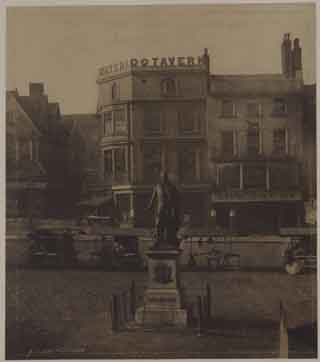1840 - 1860

Wellington Statue, Norwich Market Place
Albumen print, 1855
[Norfolk County Council Library and Information Service]
George Fitt, an artist and a photographer, worked prolifically with his cameras in Norfolk during 1854 and 1855. He was a founder member of the Norwich Photographic Society, an honorary member of the Liverpool Photographic Society and very influential in both. His photographs, usually signed and dated in the negative, reveal his predilection for buildings and landscapes. As yet, no portrait of Fitt has come to light.
In 1847, he was elected a member of the Norfolk and Norwich Archaeological Society and in 1849 he reported the finding of coins, beads, fragments and figured tiles at Whissonsett. The 1851 Census lists him as a banker’s clerk (manager), working in Fakenham, north Norfolk, and living with his wife Sarah and their three daughters at The Market, Walsingham. He soon moved to Town Close Road, Norwich and, while retaining his employment as a banker’s clerk, extended his activities into photography and showed photographs in exhibitions in Norwich, 18551 and 18562 and in Edinburgh in 18563. While in Edinburgh he wrote published documents4 from two different addresses, 56 George Street and 23 St. James Square.
He photographed the bronze statue of the Duke of Wellington, sculpted by Mr. G. G. Adams and erected in the Market Place, Norwich in 1854. It was unveiled in the presence of some 20,000 people, a military band played the National Anthem and the Royal Artillery fired a salute on Castle Hill. It didn’t take long for women street vendors to sell bottles of vinegar from wicker baskets on their arms, while leaning against the statue’s fence in the foreground of the Waterloo Arms and Snow’s Chop House. All the buildings in this photograph have long since gone and the statue was moved to its present location, in Cathedral Close, in 1937.
On 8th September 1855 he advertised in the Liverpool Photographic Journal:
‘…Mr. Fitt’s Collodion, which gives gradation of tone, detail, and purity of white unequalled. For negatives also it cannot be surpassed. Price 11d. per oz. Instructions in the Waxed-paper and all Photographic processes. Photographs for sale. Mr G. R. Fitt, Photographer, Town Close, Norwich.’The minutes of the Liverpool Photographic Society, published on 13th October 1855, record the Chairman welcoming ‘a gentleman from a distance’ and that ‘The specimens Mr Fitt had brought were certainly evidences that, whatever was being done in that city [Norwich] in a literary point of view, they were no laggards in the practical application of the art.’ He requested that Mr Fitt read a paper on ‘his wax-paper process by which he has produced some of the most pleasing and effective pictures ever exhibited to the Society.’ and on 8th January 1856 Fitt delivered his paper. He started by recommending photographers to aspire to mastery of their art. To be master of the subject ‘… he must study all processes and select from them one or more best suited to his means, time and his opportunities’ a reference to paper or collodion negatives and salted paper or albumen prints. He showed examples by an amateur friend and he claimed that one of the paper negatives had remained for one month in the camera before exposure.
He described his process of selecting and cutting paper to size, applying white wax with a warm iron and advising not to bend the paper ‘… or cracks will appear.’ Regarding the preparation of the paper he was scathing of the iodizing solutions ‘…recommended by Le Gray and some others are so complex, and contain so many articles, as to lead to a belief that the photographer intended preparing a plum pudding instead of a photographic plate. I, for my part, dispense with the rice, and the eggs and the sugar, and the isinglass, and the honey, which some gentlemen use, and in their place I use whey, …’
Briefly, he said, carry iodised paper, blotting paper, gallic acid, silver solution and glacial, acetic acid in your case and you can travel the world …
He used a three inch Ross lens with three apertures of which he usually used the medium. The focal length of the lens was 15 inches and his photographs were 11 x 9 inches. His average exposure with good light was 16 to 18 minutes. To illustrate his points he showed several examples including a negative of the Ethelbert Gate, Norwich, made in May 1856 after it had been sensitized nearly five weeks before use and another of the south transept of Norwich Cathedral over-exposed at 16 minutes on a bright October day. Yet another of a dull, red-brick building taken on a dull September day which was exactly right at 30 minutes exposure. Again he had seen many good negatives taken with a small landscape lens of 8 inch focus and three-eighths stop in 5 to 8 minutes.
He concluded by describing the use of gallic acid and hypo for developing and fixing the negatives and was thanked ‘…by acclamation for an interesting and excellent paper.’
From its inception, photography was plagued by ‘fleeting images’, and in 1855 the Photographic Society of London set up a committee to investigate the causes of fading and to establish ways of eliminating it. Fitt was well aware of the problem and read another paper to the Liverpool Society in 1856 ‘On Positive Printing’, in which he explained his preference for a method that offers ‘… permanency, artistic effect, and simplicity, …’. He continued by clearly expressing his dislike for the vulgarity of albumenized paper and the varnish of the surface… He explained his sensitising and printing technique and ended ‘…all that remains to be done is to remove the hyposulphate from the proof by several washings, and then to dry.’ He commented ‘How simple this all is, the novice will exclaim; where are difficulties in photographic printing? But stay, let us look at our print, we were very well pleased with its tint when it came from the printing frame, but alas! the rich violet has given place to a dull brick-red colour, and our print is for that reason valueless.’ He again emphasized the importance of washing the prints and recommended treating the print either in a hypo colouring bath or in a sel d’or solution. His own method was to add gold chloride to the hypo bath and fix and ‘colour’ the picture for a few minutes. He completed the process by drying the prints in blotting paper and ironing them.
Shrewdly he observed ‘… and it may be no small encouragement to photographers to try this process, when they hear that many if its admirers belong to the fairer sex, whose opinion, I think, in matters of taste is of much weight.’ He closed his paper ‘… with an earnest wish that they may prove of service to the art and science which we meet here to cultivate and improve; and if gentlemen who differ from me, or question any point or theory I have advanced, will give the benefit of their experience, I for one shall be glad to profit from it … let us use that knowledge well, and contribute each his share of permanent and artistic photographs to the general fund, and for the good of the science of photography.’ This was followed with an observation by the minute writer that‘The specimens exhibited in illustration of the systems described were among the most beautiful ever submitted to the Society. They were chiefly from street scenes in Norwich, one of them, Porch of the Norwich Grammar School, with a group of pupils and preceptors on the steps being remarkable for fidelity and depth of tone. This was shown as a specimen of whey salting solution, collodion and fixed with hypo and chloride of gold.’
Mr Fitt, duly thankful, rewarded his audience by producing an oil colour portrait, the outline of which had been projected onto the canvas by reflection from a camera, used as a magic lantern. A photograph was first taken of the person, put into a camera, and the image was then reflected from the camera onto the canvas.
Sources and Notes
- Exhibition of the Norfolk and Norwich Association for the Promotion of the Fine Arts at the Exhibition Rooms, Broad Street, St. Andrews, Norwich, MDCCCLV.
- Exhibition of the Norfolk and Norwich Fine Arts’ Association and of the Photographic Society at the Exhibition Rooms, Broad Street, St. Andrews, Norwich, MDCCCLVI.
- Exhibition of the Photographic Society of Scotland at 60 Hanover Street, Edinburgh, 1856/7.
A copy of this photograph was exhibited in 1855 at the Norfolk and Norwich Association for the Promotion of Fine Arts in the Exhibition Rooms, Broad Street, St. Andrew’s, Norwich.
- One of these was a printed leaflet listing the Rules and Regulations of the Liverpool and National Photographic Exchange Club – Associated for the purpose of receiving and exchanging photographs between its members.
CHRISTOPHER BELL ESQ. 41 Bridge Street, Birkenhead.
CHARLES COREY ESQ. 5 Slater Street, Liverpool.
G R FITT ESQ. 56 George Street, Edinburgh.
RULES AND REGULATIONS
OF THE
LIVERPOOL AND NATIONAL PHOTOGRAPHIC EXHANGE CLUB.
Associated for the purpose of receiving and exchanging photographs between its members.
Those only to be considered members who shall intimate their intention to the Secretary, and at the same time transmit a subscription of 2s. 6d. in postage stamps, to cover the expense of printing and transmission of rules, &c.
The photographs for exchange to be transmitted per post prepaid to the Secretary, not mounted on cardboard, but, rolled round a thin, light (if possible) hollow rod, and an amount of stamps enclosed to prepay return postage. The Committee would suggest that each member have his or her address legibly written on the rod, so that trouble may be saved to the Committee when they make up the exchanges.
The Committee will endeavour to allot to each member photographs of an equal quality transmitted, and a register will be kept in which will be entered the number, subjects, name and address of each sender, and the name of subjects exchanged. Therefore it is requested that the name of the photographer and the subject of the picture be attached firmly to each picture.
The exchange will be affected once each month, or according to the number of pictures in the hands of the Committee.
If any extraordinarily fine or large proofs be sent for which no equivalents may be found, notice will be given and attention called to the subject through the medium of the London and Liverpool Photographic Journals.
G. R. FITT, SECRETARY
56 GEORGE STREET, EDINBURGH
The Photographic Journal, August 16th 1859, p28 published the identical notice but the committee members are:
Christopher Bell Esq., 60 Bridge Street, Birkenhead
Charles Corey Esq., 5 Slater Street, Liverpool
G R Berry Birkenhead
